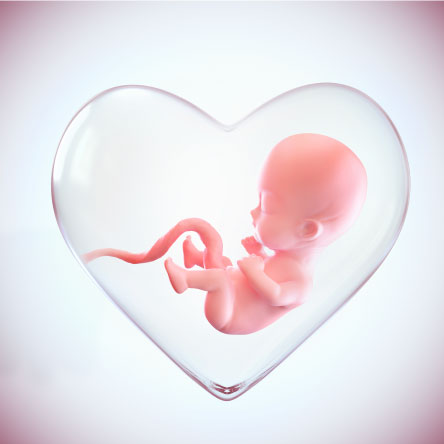Elective abortion is strictly forbidden by Halacha. Although it is not considered Retzicha when performed by a Jew, it is permissible only in very specific circumstances.[1] Even in cases of danger, Poskim are generally very careful to be certain to have a clear and definite picture of the medical situation before issuing lenient rulings. This week’s essay will discuss abortions when the mother’s life is endangered by the pregnancy.
The Mishna in Oholos states (7:6):
A woman who is experiencing difficult childbirth – one may dismember the child in her uterus and extract it limb by limb, for her life takes precedence over its life. However, if the majority of its body has emerged, one may not touch it [to dismember it], for we do not set aside one life on account of another.
In other words, before the majority of the fetus has emerged it does not have the same status as its mother, and its life is set aside for the mother’s. There are several approaches to explain this distinction.
The Gemara in Sanhedrin (72b) quotes this Mishna in the context of a Rodef (one pursuing another with intent to kill him):
R’ Huna said: One may save a person who is being pursued by a Katan [at the expense of the Rodef’s] life. He (i.e., R’ Huna) held that a Rodef does not need a warning [before killing him and] it makes no difference if he is an adult or a minor. R’ Chisda challenged R’ Huna: [Surely the Mishna states] if its head has emerged, one may not touch it for we do not set aside one life on account of another. Why not? Surely it is a Rodef? [We must say that] there it is different because “from Heaven it is pursuing her”.
Simply understood, the Gemara asserts that before a fetus emerges from its mother, it cannot be considered a Rodef since “from Heaven it is pursuing her – m’Shmaya Ka Radfi Lah”. The reason one may dismember the fetus is not that it is a Rodef but because it is not considered a “Nefesh”, as stated by Rashi (ad. loc.), the Ramah (ad. loc.), and the Ramban (Nida 44a).
However, the Rambam presents a different approach (Hilchos Rotze’ach 1:9):
It is a Torah precept not to take pity on the life of a Rodef. Therefore, the Chachamim ruled that it is permissible to dismember the unborn fetus of a woman who is experiencing a difficult childbirth, either chemically or by hand. For it is like a Rodef pursuing her to kill her. [However,] if its head has emerged, one may not touch it, for we do not set aside one life on account of another, and this is the way of the world.
These words of the Rambam are immensely surprising. The Gemara clearly states that the reason one may not dismember a fetus once its head has emerged is because it cannot be considered a Rodef – “m’Shmaya Ka Radfi Lah”. How then can the Rambam consider it to be a Rodef before its head has emerged?
R’ Chaim Brisker in his Sefer on the Rambam has an extremely novel approach to explaining the Rambam. We will summarize it in the following paragraphs:
There is a well-known Chakira as to whether the obligation to kill a Rodef is due to the need to save the person being pursued (“Hatzalas haNirdaf”) or because the Rodef is liable to death (“Din Maves l’Rodef”). R’ Chaim adduces proof to the former, however, he maintains that the obligation of Hatzalas haNirdaf is different than the regular Halacha of Pikuach Nefesh, because it involves killing another person. The Chidush of Rodef is that one individual one may put another to death in this unique case of Pikuach Nefesh.
R’ Chaim’s proof that it is not a regular Din of Pikuach Nefesh is that the source for killing a Rodef is the Pasuk, “One who spills the blood of man, his blood shall be spilled” (Bereishis 6:9). This Pasuk was addressed to Bnei Noach for whom there is no Din of Pikuach Nefesh (according to R’ Chaim); therefore, we must say that killing a Rodef is based on a different principle.[2]
R’ Chaim explains that by the terms of the regular Din of Pikuach Nefesh, one would not be permitted to kill the fetus because it too is a Nefesh for whom there is an obligation of Hatzalas Nefashos (after all, one may desecrate Shabbos on its account). According to the Rambam, the only basis for giving preference to the mother’s life is that the fetus should be considered a Rodef. Although the Gemara states that a fetus is not a regular Rodef because, “m’Shmaya Ka Radfi Lah”, that does not remove the status of Rodef entirely. If the fetus’ head has not emerged, the application of Hatzalas haNirdaf (that is, the Din of Rodef as explained above) applies such that we act to save the mother’s life since she has a “Nefesh Gemura” (unlike the fetus). However, if its head has emerged, its life cannot be set aside unless it is a fully-fledged Rodef. Since “miShmaya Ka Radfu Lah”, this is not the case.
Either way, the Halacha is clear: If a woman’s life is endangered by a pregnancy her life takes precedence and an abortion is permissible.
In view of the various approaches of the Rishonim to this subject, we can consider the following unfortunately common question. If a pregnant woman is diagnosed with cancer, the pregnancy must be terminated before chemotherapy can be administered. According to the Rishonim who state that her life takes precedence over that of the fetus, this would surely be permissible. However, according to the Rambam who holds that killing the fetus is permissible (in the scenario of a life-threatening childbirth) because it is a Rodef, this case may be different. Although the fetus can be considered to be pursuing the mother in the Rambam’s case, it is not clear that this can be said when the danger to the mother is due to an exogenous cause (e.g., cancer) and the fetus is merely preventing her from receiving lifesaving therapy.
The Poskim categorically permit an abortion in this instance, likely because the Halacha follows the other Rishonim. However, the ruling may be justified according to the Rambam as well.
R’ Shlomo Zalman Auerbach zt”l (Shulchan Shlomo, Erkei Refua 3, p104) cites the Sefer Pachad Yitzchak (Erech Nefalim)[3] who states that when a pregnant woman’s life is endangered due to something other than the pregnancy itself, an abortion is not permitted. R’ Shlomo Zalman questions this conclusion:
This requires study. Regardless, now that the woman is sick, the fetus is absolutely “pursuing” her. Though the threat is [unrelated to the pregnancy], why should we not save her or prolong her life by aborting the fetus?
In other words, according to R’ Shlomo Zalman, even if the basis for killing the fetus is because it is a Rodef, this still applies when the danger to the mother is due to another cause.
R’ Moshe Feinstein (Igros Moshe, C.M. 2:69) similarly assumes the position of the Rambam that the fetus is a Rodef. He therefore differentiates between regular Pikuach Nefesh – for which we desecrate Shabbos even for a Safek – and this case where doctors must be near certain that the mother will die before an abortion can be permitted. This is because killing a Rodef is only permissible when he is certainly a Rodef.
R’ Shlomo Zalman disagrees with this point. He asserts that this may be compared to the Din of Machteres – a home invasion – in which one may kill the burglar, even if one is unsure as to whether he poses a Sakana (Shulchan Shlomo ibid. footnote 3) or not.
On the other hand, the Achiezer[4] (3:72) appears to equivocate on this point. He was asked whether a woman with a lung disease could have an abortion since her doctors had said that this was necessary to save her life. He replied that while according to the Rishonim quoted above, the abortion was certainly permissible (since the mother is considered more of a “Nefesh” than the fetus), according to the Rambam this may not be the case. Perhaps a Rodef may only be killed when the “Redifa” is taking place at that moment, not when the danger may come at a later time. Here too, the danger of continuing the pregnancy did not pose a direct danger at that time, thus, perhaps performing an abortion was unjustified.
Ultimately, the Achiezer concludes that the Halacha follows the other Rishonim. Moreover, he states that the distinction between a Redifa taking place now and one that would only take place later is unclear.
However, the Achiezer raises another issue. A doctor’s Ne’emanus is considered by the Chasam Sofer (Y.D. 173) to be no more than a Safek. If so, when a doctor asserts that a pregnancy is posing a danger, this only renders the fetus a “Safek Rodef”, whom we may not kill. Therefore, the Achiezer concludes, that the only real basis for permitting an abortion in this case is to rely upon the view of the other Rishonim.
Overall, the Poskim agree with the Psak of the Achiezer that the danger to the mother need not be immediate. An abortion may be performed even if she would only be endangered at a future point. Though one might argue that the fetus should be granted as much life as possible before its termination, this is both impractical and dangerous. After all, perhaps she will give birth prematurely. Moreover, later abortions are more complicated and have increased risks.
There is also a deeper issue at stake. The Rishonim explain that the reason we may desecrate Shabbos to save the life of a fetus is not due to the Mitzva of “vaChai Bahem”, since it is not yet considered a Nefesh. Rather, it is due to the principle expounded by R’ Shimon ben Menasia (which is also cited l’Halacha), that we should “desecrate one Shabbos on his account so that he will observe many Shabbasos” (Yoma 85).[5] Since a fetus can expect to observe many Shabbasos in the future, Shabbos should be desecrated to save its life.
In other words, the life of a fetus is considered from the vantage point of its future potential. If so, where the fetus has no chance of ever being born, it would be permitted to abort it. Therefore, there is certainly no basis for saying that an abortion should be performed at a later time so that a fetus can live for longer.
There is one further question to discuss. If a woman has an incurable disease (she is a “Treifa”), but the abortion will extend her life somewhat, is it permissible? R’ Yitzchak Zilberstein Shlit”a discusses this question (Toras haYoledes). He quotes the Minchas Chinuch (Mitzva 296) who asserts that since one who kills a Treifa is not liable to the death penalty, perhaps the act of killing a Treifa is not considered Retzicha. If so, one who is pursuing a Treifa to kill him would not be considered a Rodef. Therefore, a pregnant woman who is a Treifa could not have an abortion (to lengthen her life) if the basis for the abortion is that the fetus is a Rodef. The abortion would only be justified according to the other Rishonim who do not permit it on the basis of Rodef.
Next week’s essay will discuss cases where the fetus does not endanger the mother’s life but prevents her from receiving other medical treatment. We will also discuss an important principle stated by the Acharonim and the controversy over the Teshuvos of the Maharit (97 & 99) on this topic.
[1] We have discussed this subject extensively in several previous essays and Chaburos. See Shemos 5780, Tazria-Metzora 5781, Pekudei 5782, and Lech Lecha 5783. See also the Chaburos on the Beis Medrash website (registration required).
[2] See, however, the Gilyonos of the Chazon Ish where he raises a question on this reasoning.
[3] R’ Yitzchak Lampronti zt”l of Padua (1679-1756)
[4] R’ Chaim Ozer Grodzenski zt”l (1863-1940)
[5] We have discussed this on various occasions in the past. See Pinchas 5779, Mishpatim and Vayikra 5783.
.















Add comment